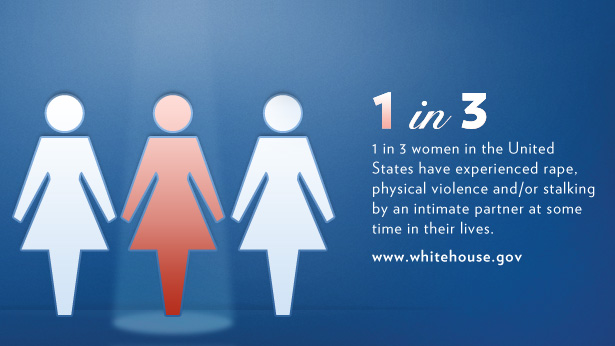1 is 2 Many Blog
By the Numbers: 1 in 3
Posted by on April 18, 2012 at 4:39 PM EDT
While 1 in 3 women in the United States have experienced rape, physical violence and/or stalking by an intimate partner at some time in their lives, domestic violence doesn’t stay within the four walls of someone’s home. It often spills over in to the workplace and can affect the safety and productivity of employees. Victims are often harassed at work or distracted from their jobs because of the abuse.
Today, President Obama directed federal agencies to develop policies for addressing domestic violence in the federal workforce. These new policies will build on ongoing efforts of federal agencies to improve workplace safety, and outline steps employers can take to provide support and assistance to employees whose lives are affected by domestic violence.
Learn more about WomenThe Next Step in Combatting the Spread of HIV/AIDS Among Women and Girls
Posted by on March 30, 2012 at 11:08 AM EDTAs the Executive Director of the White House Council on Women and Girls, it is my honor to join Dr. Grant Colfax, Director of the Office of National AIDS Policy and Lynn Rosenthal, the White House Advisor on Violence Against Women, in announcing the next step in President Obama’s commitment to combat the spread of HIV/AIDS amongst women and girls. Please read on for more details.
There are approximately 1.2 million people living with HIV/AIDS in the United States, including more than 290,000 women. Black and Hispanic women account for nearly three-quarters of new HIV infections among women. In July 2010, President Obama launched the first National HIV/AIDS Strategy to provide a coordinated national response to fight the epidemic, with the goals of reducing new infections, improving health outcomes, and decreasing HIV-related health disparities. This past World AIDS Day, the President said that “When black women feel forgotten, even though they account for most of the new cases among women, then we’ve got to do more." President Obama was joined by Secretary of State Hillary Rodham Clinton in a call to our partners—including government stakeholders at all levels, healthcare professionals, and HIV/AIDS service providers—to unite in an effort to usher in an “AIDS-free generation.” To reach this goal, it is clear we must address HIV among women, particularly among women of color.
As directed in the National HIV/AIDS Strategy, Federal agencies are collaborating in new ways. We are embracing scientific findings to implement evidenced-based prevention methods in order to be more effective at preventing new HIV infections, and we are exploring new approaches to integrate prevention and care. As part of this ongoing collaborative approach, President Obama has issued a presidential memorandum establishing an inter-agency working group on the intersection of HIV/AIDS, violence against women and girls, and gender-related health disparities. The President has asked Lynn Rosenthal, the White House Advisor on Violence Against Womenand Dr. Grant Colfax, the Director of the Office of National AIDS Policy, to serve as co-chairs.
Learn more about , WomenTogether We Must End Dating Violence
Posted by on February 27, 2012 at 11:38 AM EDTOver the past month, college newspapers across the country have run an op-ed penned by Vice President Biden in which he urges college students to take action to help put an end to dating violence and sexual assault on their campuses. February is Teen Dating Violence Awareness and Prevention Month, and Vice President Biden took the opportunity to remind students that dating violence is still a very real problem in our country.
The facts are clear: nearly one in five college women will be the victim of a sexual assault, and one in ten teens will be hurt by someone they are dating. As the Vice President wrote, these are not merely statistics, “these are the people you know: your roommates, your friends, your sisters, and your classmates.”
As the Vice President has often said, we all have an absolute obligation to try to stop abuse when we see it – no matter what. That’s why this Administration is working so hard to confront the problem head on.
Last April, new standards were announced that make it clear that colleges are responsible for creating campus environments that refuse to tolerate dating violence. And in September, the Vice President launched the “1 is 2 Many” project – an effort to change attitudes that lead to violence and educate the public on the realities of abuse.
Senate Judiciary Committee Passes Violence Against Women Act
Posted by on February 14, 2012 at 12:43 PM EDTOn February 2, the Senate Judiciary Committee passed the reauthorization of the Violence Against Women Act (VAWA). Even though VAWA has a bipartisan group of co-sponsors, the eight Republicans on the committee voted against this critical piece of legislation. Now the Act goes to the full Senate for consideration.
First authored by then Senator Biden in 1994, VAWA provides funding to states and local communities to improve the criminal justice response to domestic violence, dating violence, sexual assault and stalking. VAWA supports specialized law enforcement units to investigate these crimes and helps prosecutors get dangerous offenders off the streets. VAWA also protects victims living in subsidized housing from being evicted after suffering domestic violence, supports training for health care providers, and brings help to victims in rural areas of the country. The hallmark of VAWA is the coordinated community response, bringing different agencies together to create a seamless approach to combating violence.
One day’s look at the headlines tells us why we still need VAWA. Domestic violence often spills into streets, workplaces, and communities, and is estimated to cost our nation 8 billion dollars a year in lost productivity and health care costs. This violence causes more than two million injuries each year, three deaths each day, and untold amounts of suffering to women. The hidden crime of stalking affects 1 in 6 women and 1 in 19 men, and sexual assault remains the most underreported violent crime in the country. 1 in 5 women and 1 in 71 men have been sexually assaulted at some time in their lives, most before the age of 18.
It's fitting that the Senate Judiciary Committee took up VAWA during Teen Dating Violence Prevention and Awareness Month, because teens and young adults are at THE highest risk for this violence. The proposed legislation provides funding to schools, youth groups, and victim service agencies to develop new strategies to intervene in and prevent dating violence and sexual assault. If we can stop violence in this generation, some day we won’t need these services. But today, the need is still urgent. We need the full Senate to approve VAWA reauthorization and for Congress to send this legislation to President Obama to sign into law this year.
Learn more about WomenRaising Awareness About Stalking
Posted by on January 30, 2012 at 2:28 PM EDTJanuary is Stalking Awareness Month, and it’s an important to highlight a crime that is often invisible. According to the latest data from the Centers for Disease Control (CDC), 1 in 6 women and 1 in 19 men will be stalked in their lifetimes. Young women ages 18-19 experience the highest rates of stalking. The fears, threats and intimidation endured by victims is often felt by family members as well.
To mark this important month, this week we hosted the first ever White House stalking roundtable with survivors, law enforcement officers, victim advocates, and researchers. We learned from law enforcement experts that while many victims are stalked by ex-partners, others can be stalked by acquaintances and even strangers. Stalkers often track their victims’ daily lives and make themselves known in ways that are scary and unpredictable. Stalking can force victims to change everything about their lives in order to be safe.
I commend the bravery of two survivors who shared their stories. One woman was stalked by an ex-husband while another was stalked over a long period of time by someone she barely knew. Both were terrorized through cyber stalking and a range of strategies designed to keep them on constant edge and make them feel afraid every day. The stalking extended to family members and children, making it even more terrifying. Their stories put a human face on the statistics and helped us understand the true personal cost of stalking.
Reauthorizing the Violence Against Women Act
Posted by on November 30, 2011 at 2:22 PM EDTToday, Senate Judiciary Committee Chairman Pat Leahy (D-Vermont) and Senator Mike Crapo (R-Idaho) introduced bipartisan legislation to reauthorize the Violence Against Women Act (VAWA).
First championed in 1994 by then-Senator Biden, VAWA transformed the nation’s response to domestic violence and sexual assault. VAWA has provided funding to states and local communities to develop specialized law enforcement units, provide services to victims, and improve prosecution of these crimes. Since the passage of the Act, the annual incidence of domestic violence has dropped by more than 50%.
While tremendous progress has been made, violence is still a significant problem facing women, men, families, and communities. Three women die every day at the hands of husbands or boyfriends. Domestic violence causes two million injuries a year to women and untold amounts of human suffering. Domestic violence shelters are still full, hotlines are ringing, and for every victim who has come forward, many more are suffering alone. And it’s the nation’s youth who are most at risk – young women between the ages of 16-24 suffer from the highest rates of dating violence and sexual assault.
Learn more about Women
- &lsaquo previous
- 1
- 2
- 3
- 4
- 5
- 6
- 7
- next &rsaquo
White House Blogs
- The White House Blog
- Middle Class Task Force
- Council of Economic Advisers
- Council on Environmental Quality
- Council on Women and Girls
- Office of Intergovernmental Affairs
- Office of Management and Budget
- Office of Public Engagement
- Office of Science & Tech Policy
- Office of Urban Affairs
- Open Government
- Faith and Neighborhood Partnerships
- Social Innovation and Civic Participation
- US Trade Representative
- Office National Drug Control Policy
categories
- AIDS Policy
- Alaska
- Blueprint for an America Built to Last
- Budget
- Civil Rights
- Defense
- Disabilities
- Economy
- Education
- Energy and Environment
- Equal Pay
- Ethics
- Faith Based
- Fiscal Responsibility
- Foreign Policy
- Grab Bag
- Health Care
- Homeland Security
- Immigration
- Innovation Fellows
- Inside the White House
- Middle Class Security
- Open Government
- Poverty
- Rural
- Seniors and Social Security
- Service
- Social Innovation
- State of the Union
- Taxes
- Technology
- Urban Policy
- Veterans
- Violence Prevention
- White House Internships
- Women
- Working Families
- Additional Issues


